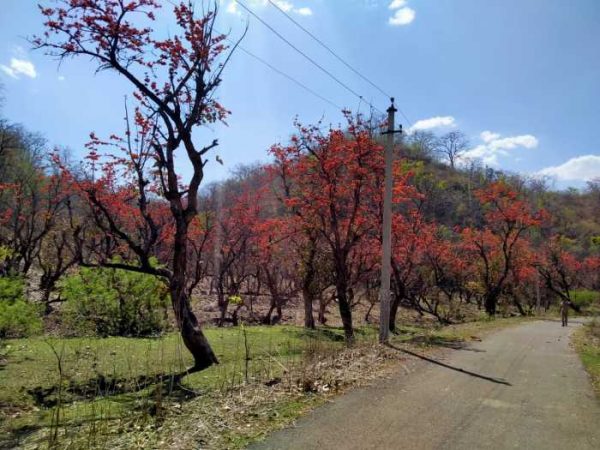



Udaipur : The forest department had planned to hold the first of its kind Palash festival last month however, after things went awry due to the lock down, the event was called off. However, nature seems to be rejoicing the blooming season of the beautiful tree as the ‘Flame of the forest’ is painting the Aravalis range red. Amid the groves of Palash trees blooming with bright orange-vermilion color flowers one can see a multitude of birds assemble on the flowers to seek nectar from it like common Myna, white eye, purple rumped Sunbird, Yellow throated sparrow, rose ringed parakeet, tailor bird and plum headed parakeet. Many birds seen in groups are rosy starlings. Many butterflies, wasp and Honey bees also visit it. Langoor raid it to eat the flowers. Little green bee eater also remains present to eat the Honey bees! It is just like a festival during its blossom.
“In the Samar forest block in Udaipur, 20 kilometers away from the city, is a whole valley blooming with Palash these days. We had planned to hold the festival here, unfortunately it had to be called off. However, the lockdown has come as a boon for the nature and wild life in general as the pollution level has considerably decreased. We are observing better and safe movements of avian species. Also there are less trampling of snakes and other animals on roads and the stress on the wild life has reduced to a great extent” Rahul Bhatnagar, ex CCF told .
The forest department in collaboration with voluntary organisations had planned the Palash festival to spread awareness on the need to conserve the tree which was once found in abundance in the region. ” Like many other trees growing in forest the Palash is also lopped for fuel wood and other purposes. So we need to conserve it like many other trees, we need to create awareness about its importance to children and general public” Bhatnagar said. Authorities are planning to develop Palash groves near cities to develop a bond between the tree and the people, so that they can also appreciate its beauty and association with birds and animals.
“Palash is part of our history and culture. It finds mention in our art, litrature and ancient text like ‘Puranas’. Palash is known as Kimshuk, Harni, Dhak, Cheela, Khakara and Tesu . Its scientific name is Butea monosperma. It is small in size tree and mostly grows upto 15 meters height in dry – deciduous forest. The tree trunk is crooked in shape. In 10 years it grows to around 20 cms in thickness” Bhatnagar said.
Palash leaves are arranged in bunch of three leaflets to be made into ‘donas’. The flower is fleshy and remains fresh for quite some time. Colour and shape of its flower is unique and beautiful. The fresh flowers do not have any smell but when flower are lying in a heap rotting then they emit a sweet smell. It is a dominant tree in many parts of its range and is found in good number in those areas. In such areas their cumulative blossom creates a magical impact which colours the sky and and the ground below with red colour. This creates an image of fire because of its red colour and pointed flower which look like flames emitting out .
Plates and other utensils are made from its leaves. The flowers are soaked in water to take bath from that water which is supposed to be an excellent moisturizer and an antidote for skin aliments of children. Roots are used to make ropes. It is also used to to secure dam bund from washing down during rains. Colour extracted from its flowers can also be used to colour various foods . Sharbat can be made after soaking flowers in water. It is a useful medicinal plant . Its dried branches are used for havan.
